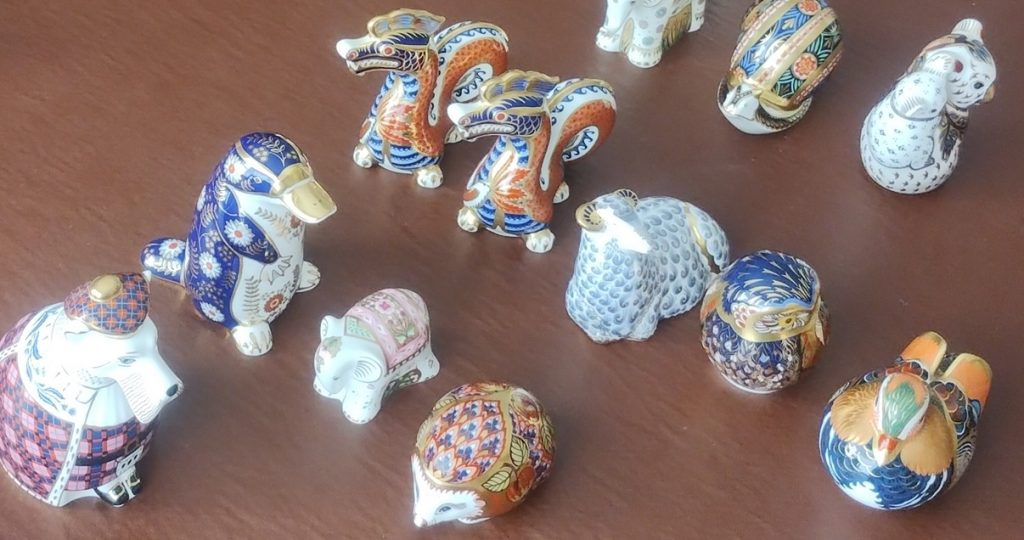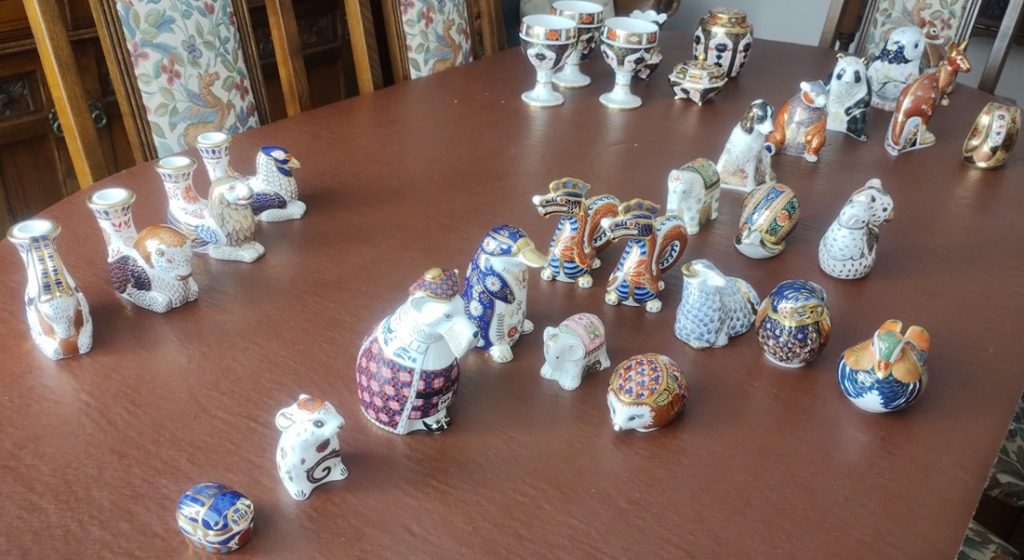Buying things in bulk is usually a good way to get a cheaper unit price and so it is with art and antiques. When multiple items are sold as a lot at auction, this is especially true.
Needing to stock up on Royal Crown Derby ceramics and paperweights we recently took advantage of an auction at Dawsons of Maidenhead where several multi-item lots drew our attention. The only downside was most of a day’s driving to collect our winnings.

Multi-item auction lots, low value items and the minimum bid
Many auction lots include multiple items. On a good day, for the winning bidder these lots can be very good value.
Most auction houses have a minimum bid below which they won’t take offers. One of our local auction house is Littleton Auctions. They operate a strict £10 minimum bid which I’ve only seen broken when filming the television program Antiques Road Trip. Littleton have recently extended their guidelines to only accept items with a reasonable expectation of achieving a minimum selling price of £30.
A minimum target selling price is a very sensible rule. Auction houses receive more items than they can reasonably sell. It can take almost as long to sell a £20 lot as it can to sell a £200 lot and for the latter the income is, not surprisingly, about ten times as much. The associated paperwork is also much the same, regardless of the selling price. Auctions can only go on for so long and even the best auctioneers have limited stamina. Even with multiple auctioneers there has to be a limit.
Grouping items for sale
This does leave a problem though. Many small, lower value items are still worthy of sale. Because no one can sell them, it would be a shame for them to be disposed of. The commonest solution is to group related items together in a single lot.
Sometimes the grouping is obvious, sometimes it’s pretty tenuous. Selling a china dinner service piece by piece would be silly, but collections of almost anything can make for attractive lots. The most random collections are always worth looking through. We’ve bought several lots for single items that made the rest worthwhile, one of which I wrote about some time ago.
Collectors, being collectors, often accumulate a very large number of related items. For sale, these tend to be split up into multiple lots. On the other hand I once saw 300 teapots offered in one go – they didn’t sell. I have no idea why the vendor insisted on selling them as a single lot. The auctioneer clearly didn’t want to. I think his comment was “I knew that would happen. A waste of everyone’s time”.
The allocation of items to lots can look arbitrary, but there is method to it. To increase the chances of selling everything, less valuable items are grouped with one or two more desirable ones.
As a buyer, this can be frustrating. To obtain the best items, you have to pay for something you don’t really want. However, on a good day it can mean that you pay a reasonable price for the better items and the others come for free. If you’re selling everything on, anything you get for the cheaper items is money for almost nothing.
Travelling to buy at scale
Some of the auction houses we frequent have a target minimum lot value well above that of Littleton Auctions. These tend to be larger organisations that handle far more stock and consequently sell quite eye-watering amounts. One of our regular haunts is Potteries Auction who have two sites around Stoke on Trent. At Potteries we tend to buy our Moorcroft and Royal Crown Derby ceramics in lots of two or three items at a time.
Stoke is quite a long trek from Worcestershire but we have family we can meet up with, so trips to Stoke are not just for buying. Even without the family connection, it would usually be worth our while to travel to Stoke for auctions. In a single auction we can easily buy 10+ items by winning three or four lots. Sourcing that many items locally could take months and would cost more in terms of time, effort and fuel. Potteries do offer an excellent in house packaging service but it’s cheaper for us when we’ve bought a crate full of ceramics to collect them ourselves.
Going large, going to Maidenhead
We were in need of some Royal Crown Derby, Imari 1128 pattern, ceramics having recently sold quite a lot. Looking through online auction catalogues we came across an auction at Dawson’s in Maidenhead. Initially we dismissed the idea of bidding on the basis that Maidenhead was too far for us to economically travel. However, the more we looked at the catalogue, the more compelling the idea of bidding became.
Sat. Nav. has transformed how we look at visiting distant auction houses. In the past, finding an address on some out of the way industrial estate was bad enough, but finding a business in the middle of a town or city could be a nightmare. I’d defy anyone to find Adam Partridge Auctions in Macclesfield with only a road atlas to help (although if you manage, it’s an outstanding place to visit and buy from). So with the aid of Google maps showing me various suggested routes to Dawson’s (four different, depending on the level of traffic chaos around Oxford), we decided to bid.
Dawson’s turned out to be a step up from our usual sources of ceramics. Their target price per lot seems to be at least £200 to £300. To achieve that with Royal Crown Derby paperweights, instead of the usual grouping or two or three items (or even selling them individually), Dawson’s grouped items ten to fifteen at a time. Of the Royal Crown Derby lots on offer, half dozen were of interest. It was one person’s collection. It was amazing to see.
Because of the distance we decided to take a chance on the condition of the items without viewing. This is always a risk and I wouldn’t recommend it to anyone new to buying at auction. In this case Dawson’s seemed to highlight one item with damage, which is always a good sign. For me, it’s unforgivable for an auction house not to mention obvious damage in the standard description, but it often happens. As it turned out, the pieces we won were all in perfect condition.
We won two lots, comprising just over 30 items. Some peices we’d seen and sold before, some were completely new to us. It’s always a pleasure to buy items you’ve not handled before and so it was with some excitement I set off for collection.
Collecting my winnings
Dawson’s is on a rather smart industrial estate one the edge of Maidenhead. The drive down took a little over two hours but I was entertained by the sight of about a dozen Red Kites over the A404. As a lifelong birder who had to travel to mid-Wales to see his first Red Kite in the late 1980s the sight of them throughout the Cotswolds and Chilterns is always a joy.
Having arrived, getting into Dawson’s actually requires using an intercom to announce yourself. You’re then led into a very swanky office area more akin to a decent hotel. This is very different to some of the places we buy from, the extreme of which look more like Steptoe and Son’s scrap yard. I felt a bit underdressed so I was relieved that collection was very quick and efficient.

To ensure our new purchases travelled safely, for once I’d been packed off with enough bubble wrap and packaging . If you’re doing this for the first time, don’t underestimate the amount of packaging you need, especially if you’ve bought mixed crates of breakable items. As items get wrapped, they can double in volume, so you can never have enough packaging. I recall not doing so on an early trip to The Cotswold Auction Company. Driving home from Cirencester, the contents of my car sounded like a milk float going over rumble strips.
Courtesy of Google Maps guidance, my return route was almost entirely different to out outward drive but it only took a few minutes longer. I made it home a little over five hours after setting out. All in all a very worthwhile exercise and one I’d be happy to repeat. All we need now are some lovers of Crown Derby and a chance to meet them.